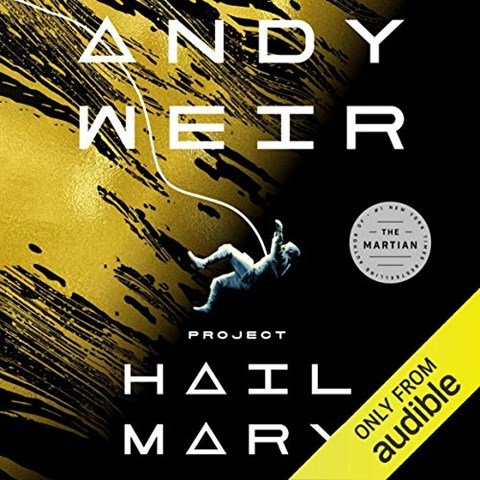
It’s hard sf, a scientific mystery. It’s one man alone, on a one-way mission he never really agreed to. And it’s a first contact story. It’s the hard sf adventure I loved in the Sixties and Seventies, without the latent and sometimes blatant sexism. Ryland Grace is a scientist who found happiness as a middle school science teacher, and finds himself hijacked back into research to save our species from extinction, and into a one-way journey to Tau Ceti.
Project Hail Mary, by Andy Weir (author), Ray Porter (narrator)
Audible Studios, May 2021
Review By Lis Carey: Ryland Grace was a microbiologist, and then he wrote a paper that pissed everyone off. He quit and became a schoolteacher. He was very happy as a schoolteacher.
And then another scientist, in a very different field, saw something strange happening to the sun, and a strange, infrared radiation line connecting the sun and Venus. When amoeba-like forms were identified as the likely cause, someone decided it was right up Ryland’s alley.
Which is why, one day, he wakes up in what at first seems to be a very strange hospital room. His two fellow patients have died — years ago, from the states of their bodies. He doesn’t know why he’s here; he doesn’t even know his own name. Which is especially awkward, because the automated computer system won’t answer some critical questions until he can correctly give his name.
Slowly, little accidents trigger some memories. His name comes back. He remembers being a teacher, and then having been a scientist before that. Together with his cautious exploration of where he is, he realizes he’s on a spaceship, headed — somewhere.
Gradually, he remembers why he’s here. The amoeba-like things are eating the sun’s energy, fast enough to become an extinction-level event if they’re not stopped. And nothing on Earth can stop them. Worse, all the stars in Sol’s neighborhood are infected and suffering the same fate.
Except Tau Ceti. Tau Ceti has the amoeba things, but it is somehow controlling them. Tau Ceti has a resistance that other stars, including Sol, don’t have.
Ryland Grace is the sole surviving member of a three-person crew dispatched to find the answer, and send the information back to Earth. It was a suicide mission anyway; not enough fuel to return the crew. Just four, much smaller, “beatles” to provide redundancy in the return of the information. Now the chances of success are even longer.
Then he makes another worldview-shattering discovery. Humanity isn’t alone after all. There isn’t just other life, the sun-killing amoeba, but other intelligent life. Not from Tau Ceti, but from 40 Eridani.
Ryland isn’t alone anymore, and all his expectations have been turned upside down and inside out.
It’s a hard sf story, just as we would expect from Andy Weir. It’s a scientific mystery. And it’s a first contact novel, with two very good main characters, and a variety of interesting and complicated characters whom we meet as Ryland recovers his memories, in fits and starts and not necessarily in order. The narration is excellent, making the characters clear and distinct.
Highly recommended.
I received this book as a gift.

Discover more from File 770
Subscribe to get the latest posts sent to your email.

Clickity
Thanks for the review – if I hadn’t already read the book, your review would have put it at the top of my (aleph-null length) to-read list.
I really like Andy Weir’s style.
I really enjoyed this book. Except for the very end. I find it hard to accept that anyone would really be content in that situation
I thought it was going to be a well crafted, reader friendly hard sf book, and it was. But it was also more. Your review captured that and if I hadn’t already read it, I’d certainly do so now.
I thought it was a fun book. I read it in paper book form. But friends of mine listened to it as an audiobook, and having heard part of it while getting a ride to the metro from them, I also think they did a great job with the audiobook.
It was a good book (and a great review!) even if it missed some science parts in e.g. how languages actually work
While I was reading the book, I came up with what I thought was a fairly strong mitigation strategy —
pbafgehpg tvnag fcnpr zveebef (jung XFE va gur Znef gevybtl pnyyrq n “fbyrggn”). Vs gur fha vf trggvat qvzzre, oevat va zber fhayvtug sebz fcnpr. Vs lbh pna ohvyq na vagrefgryyne fcnprpensg, fhpu n cebwrpg srryf rnfl ol pbzcnevfba.
And I figured that if I could think of that in just a couple of hours, people much smarter and more motivated than me with more time available certainly would, and more besides. But Weir finessed this
ol univat uvf cebgntbavfg abg trg onpx gb Rnegu. Fb ur jnf fcnerq sebz univat gb guvax hc nalguvat nybat gubfr yvarf. Jungrire jr zvtug guvax bs, jr pna whfg nffhzr gung crbcyr qvq. V’z ubarfgyl abg fher jurgure V guvax gung jnf pyrire, be n pbcbhg.
It’s likely they did think of it, but Grace wouldn’t have been thinking of engineering solutions, even before he got hijacked off to Tau Ceti.
But it would only have been mitigation. It would have helped survive the wait for a solution, but wouldn’t have solves the problem. They still needed a way to control the amoeba.
@David Goldfarb: Grace’s mission has a built-in time-delay for results, so it makes sense to start that one first – your idea might me what Earth did while Grace was away.
Great review, @Lis Carey! I listened to the audiobook, narrated by Ray Porter, and it was great! Weir’s four-for-four with me (the three novels and the graphic novel “Cheshire Crossing”). 🙂
@Kendall–I didn’t know he had a graphic novel!
@Lis Carey: Heh, I recommend the graphic novel! It’s pretty amusing and a good story.
FYI you can read it free online with his old artwork. It’s not great artwork, but it fits well with the feel of the story, so it grew on me. Then there’s a published version with new (much better) artwork; I got that, too. 😉
P.S. I forgot to include the link to “Cheshire Crossing”: http://www.cheshirecrossing.net
@Kendall–Thanks!